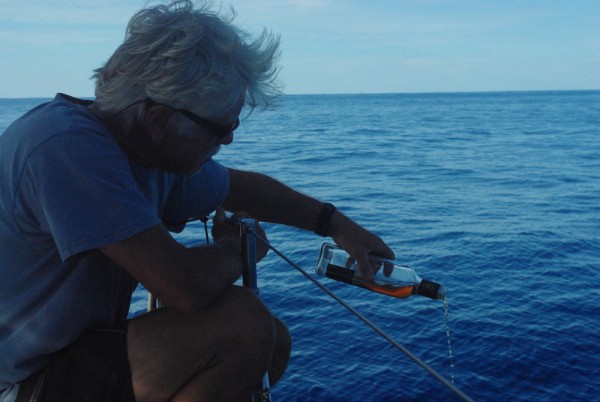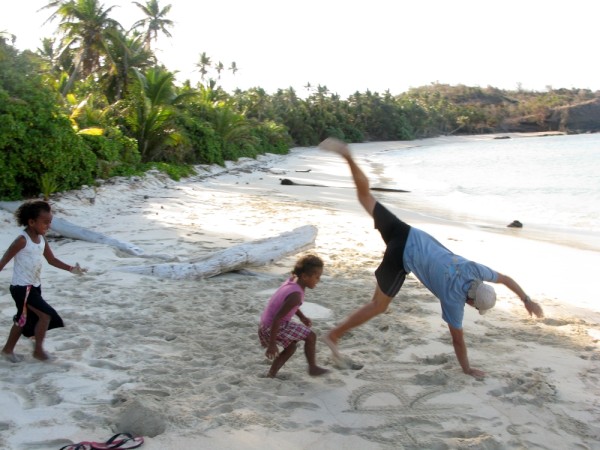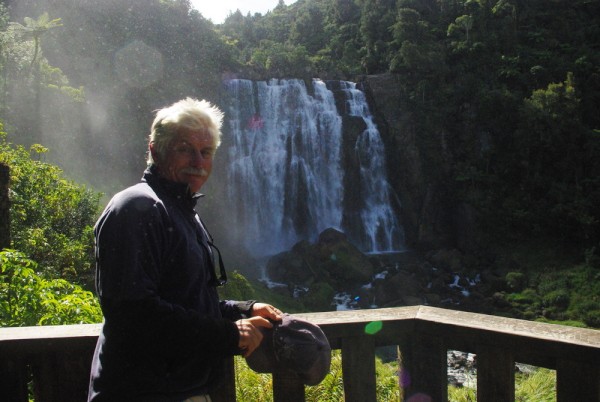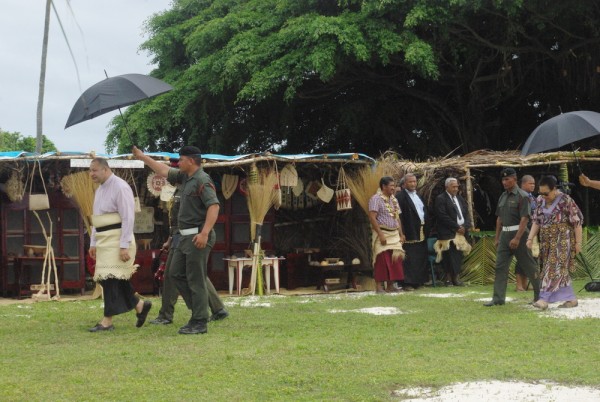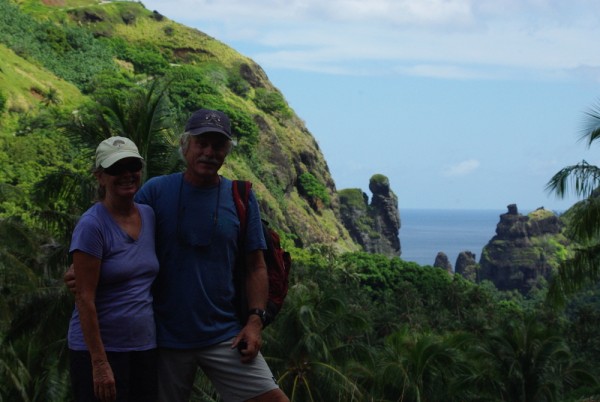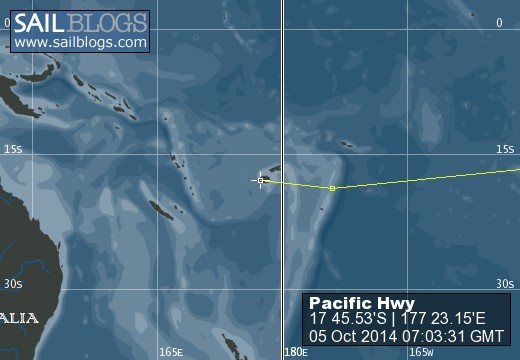
Pacific Hwy
10 January 2017 | Lechinioch
15 March 2016 | Sydney Australia
23 April 2015 | Majuro, Marshall Islands
08 November 2014 | Tarawa, Kiribati, Middle of the Pacific Ocean
27 October 2014 | Lautoka, Fiji
04 October 2014 | Fiji
19 February 2014
20 August 2013
28 July 2013
20 May 2013 | French Polynesia
19 May 2013 | Makemo
19 May 2013
11 May 2013
12 April 2013
11 April 2013
10 April 2013 | Latitude 00.00
07 March 2013 | Banderas Bay
02 February 2013 | Nuevo Vallarta
21 January 2013 | Mexican Riviera
09 January 2013 | Chamela Bay
Iles du Desappointment and The Quasi-Stationary Front
19 May 2013 | Makemo
We use various weather sources - some are blogs by people who have sailed here before us and some are written by semi-professional weather nerds, some are in French and some have to be decoded with a special program. We've learned that pause should be given to the term "quasi-stationary front" as it may give pause to your sailing.
It was time to leave the Marquesas. We wanted to avoid the steep seas and 20-25 knot winds that we'd experienced on our overnight sail to Nuku Hiva. PACIFIC HWY likes light air. She glides at 7 knots with a 12 knot breeze.
Our weather map showed a 'quasi-stationary low" off Fiji and then New Zealand - some 2,000 miles to our southwest. We'd been seeing it on the weather reports for a week and, although it was far away, it seemed to be sucking up the air and causing lighter winds in our latitudes. Perfect for our 430 mile run to the Tuamotus, our next island group. We'd done the 430 mile run from Grenada to St. John several times with our catamaran, AMARYLLIS and it always took about 60 hours. We were confident that PACIFIC HWY would be just as fast. We've been bragging about our boat since our under-17-day trip from Mexico to the Marquesas - possibly the fastest trip this year among boats of similar size. So, with great expectations about an easy 60 hour trip, we depart.
We are now in our third day of our passage and only half way there. The light breeze we were promised is too light and refuses to settle down to one steady wind direction. Instead, the wind veers as much as 180 degrees. We are sailing downwind with a preventer line to hold the boom in place but the wind shifts from one side of the sail to the other with a noisy slap. The wind vane atop the mast moves like a metronome: slap-slap, slap-slap. The captain's getting cranky. Bragging rights evaporate along with morale. I console myself that at least this is only a 430 mile trip. Our friends on SLOW RIDE made the 2700 mile trip across the Pacific with little wind and a malfunctioning engine. It took them 36 days (be careful what you name your boat!). Meanwhile we are wondering when we will get those fabled southeast tradewinds. Or something even close. On the chart we pass an island called "Iles du Desappointment". You don't need to know French to get the meaning.
On day four we realize we can't make landfall during daylight hours so we will sail an additional 60 miles to the next atoll. We take down our working jib and put up our bigger, Southern-California-light-air sail. We probably should have done this the first day but with the dinghy lashed down on the foredeck there's no room to maneuver and it's a challenge on a moving deck. I wonder if we're getting lazy or just old.
I wake up for my next watch thinking I just can't go back on deck and listen to that awful slapping. But the wind has shifted and it looks like we have our light southeast trades! PACIFIC HWY takes off and we have a perfectly quiet and gentle sail for the last day and night of our passage.
The Tuamotu Atolls are narrow strips of low, reef-formed land, usually circular and surrounding a lagoon. You enter through a narrow pass at slack water as the current rips through the pass at up to 8 knots. We arrive in daylight with 3 hours to spare before slack water. Bruce discovers a problem with our engine. He goes below to deal with it and I tack through a lazy figure eight in perfect sailing conditions. I am so thankful that the engine problem manifested itself when we have time and calm weather on our side. At slack water the engine is fixed, we drop sails and motor easily through the pass. The anchorage is beautiful. The lagoon is 40 miles by 10 miles surrounded by a ribbon of white sand and palm trees. The water changes from purple-blue to translucent green depending on the depth. The air smells like perfume. We are the only boat here. Aaahhhhhhh.
It was time to leave the Marquesas. We wanted to avoid the steep seas and 20-25 knot winds that we'd experienced on our overnight sail to Nuku Hiva. PACIFIC HWY likes light air. She glides at 7 knots with a 12 knot breeze.
Our weather map showed a 'quasi-stationary low" off Fiji and then New Zealand - some 2,000 miles to our southwest. We'd been seeing it on the weather reports for a week and, although it was far away, it seemed to be sucking up the air and causing lighter winds in our latitudes. Perfect for our 430 mile run to the Tuamotus, our next island group. We'd done the 430 mile run from Grenada to St. John several times with our catamaran, AMARYLLIS and it always took about 60 hours. We were confident that PACIFIC HWY would be just as fast. We've been bragging about our boat since our under-17-day trip from Mexico to the Marquesas - possibly the fastest trip this year among boats of similar size. So, with great expectations about an easy 60 hour trip, we depart.
We are now in our third day of our passage and only half way there. The light breeze we were promised is too light and refuses to settle down to one steady wind direction. Instead, the wind veers as much as 180 degrees. We are sailing downwind with a preventer line to hold the boom in place but the wind shifts from one side of the sail to the other with a noisy slap. The wind vane atop the mast moves like a metronome: slap-slap, slap-slap. The captain's getting cranky. Bragging rights evaporate along with morale. I console myself that at least this is only a 430 mile trip. Our friends on SLOW RIDE made the 2700 mile trip across the Pacific with little wind and a malfunctioning engine. It took them 36 days (be careful what you name your boat!). Meanwhile we are wondering when we will get those fabled southeast tradewinds. Or something even close. On the chart we pass an island called "Iles du Desappointment". You don't need to know French to get the meaning.
On day four we realize we can't make landfall during daylight hours so we will sail an additional 60 miles to the next atoll. We take down our working jib and put up our bigger, Southern-California-light-air sail. We probably should have done this the first day but with the dinghy lashed down on the foredeck there's no room to maneuver and it's a challenge on a moving deck. I wonder if we're getting lazy or just old.
I wake up for my next watch thinking I just can't go back on deck and listen to that awful slapping. But the wind has shifted and it looks like we have our light southeast trades! PACIFIC HWY takes off and we have a perfectly quiet and gentle sail for the last day and night of our passage.
The Tuamotu Atolls are narrow strips of low, reef-formed land, usually circular and surrounding a lagoon. You enter through a narrow pass at slack water as the current rips through the pass at up to 8 knots. We arrive in daylight with 3 hours to spare before slack water. Bruce discovers a problem with our engine. He goes below to deal with it and I tack through a lazy figure eight in perfect sailing conditions. I am so thankful that the engine problem manifested itself when we have time and calm weather on our side. At slack water the engine is fixed, we drop sails and motor easily through the pass. The anchorage is beautiful. The lagoon is 40 miles by 10 miles surrounded by a ribbon of white sand and palm trees. The water changes from purple-blue to translucent green depending on the depth. The air smells like perfume. We are the only boat here. Aaahhhhhhh.
Comments
| Vessel Name: | Pacific Hwy |
| Vessel Make/Model: | Davidson 44 |
| Hailing Port: | St. John, USVI |
| Crew: | Bruce and Laura Masterson |
| About: | After 30 years sailing the Caribbean and the Atlantic, we are checking out the 'Left Coast" and the Pacific. |
| Extra: | Our boat was previous named Pacific Coast Hwy. We have renamed her Pacific Hwy and plan to leave the coast behind. |
Sailing Pacific Hwy
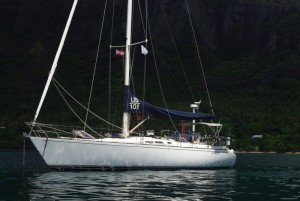
Who: Bruce and Laura Masterson
Port: St. John, USVI
